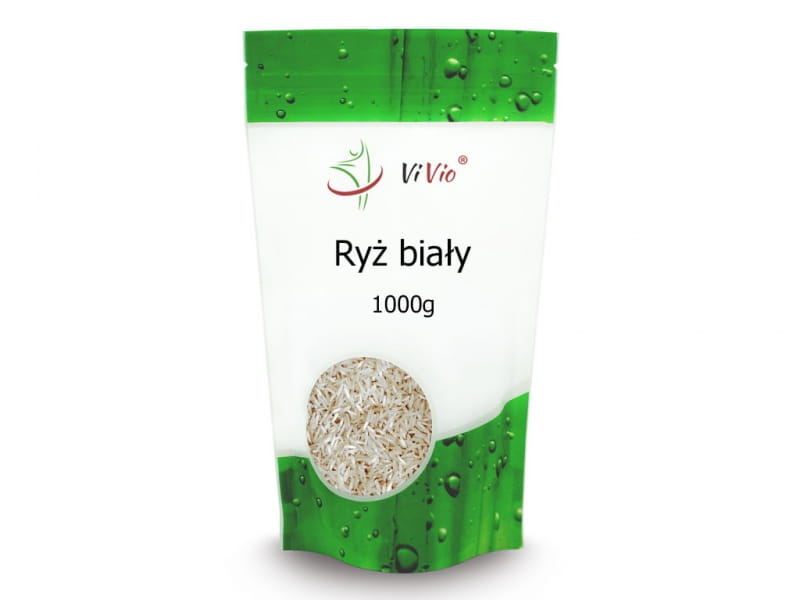Basmati rice 1000g - VIVIO
- Regular price
- €5,97
- Regular price
-
- Sale price
- €5,97
- Unit price
- per
Couldn't load pickup availability
Description
xOf all the types of rice on the market, white rice is the most popular. Among other things, individual types are differentiated based on the length of the grains. On store shelves we can find short-grain rice (pearl, most commonly used for sushi), medium-grain rice (arborio, carnaroli, vialone, loto) and long-grain rice (jasmine and basmati). Another division is the classification of rice according to the degree of cleaning and processing of the grains. Here a distinction is made between brown rice, which is free of chaff and germ but has a dark hull, white rice (free of chaff, germ and hull) and parabolic rice (highly cleaned and additionally thermally treated, giving it a characteristic yellow colour). Color). Basmati rice belongs to the long grain rice group. Its grains are very long and needle-like, and when cooked they even increase in size, are very tender and fluffy. Plain jasmine white rice has slightly shorter and rounder grains. Both types also differ slightly in terms of calorific value. The Basmati variety also has a significantly lower glycemic index (IG 58) than plain white rice (IG 109).
Rice provides our body mainly with carbohydrates. It contains a small amount of protein (about 6.8 g) and a negligible amount of fat. It is also characterized by a high starch content. Its two main components - amylose and amylopectin - affect the structure of rice after cooking. Basmati rice contains higher amounts of amylose, which keeps the grains from sticking together after cooking.
The dietary fibers contained in rice stimulate intestinal peristalsis and have a positive effect on the digestive system. White basmati rice is an easily digestible product, so it is an important part of the diet of people suffering from diseases of the digestive system. According to scientists, white rice can also complement the treatment of kidney disease and arterial hypertension (due to the low sodium content).
INGREDIENTS
White basmati rice.
The product may contain: gluten, nuts, sesame seeds and derivatives.
NUTRITIONAL VALUE OF THE PRODUCT PER 100 g
Calorific value - 1555 kJ / 367 kcal
fat - 1.03 g
- of which saturated fatty acids - 0.29 g
Carbohydrates - 80.89 g
- of which sugar - 0.33 g
Dietary fiber - 1.8 g
Protein - 7.51g
Salt <0.01g
NET WEIGHT: 1000 g
INSTRUCTIONS FOR USE
White basmati rice must be properly prepared before consumption. The first step is to soak the beans in water. This should take between half an hour and even two hours. This allows the grains to absorb some water and cook them evenly. When cooking, it is important to keep the right proportions. One and a half servings of water should be used for one serving of rice. Cook the rice in salted water, bring to the boil, then reduce the heat and cook, covered, for about 10 minutes. During this time we do not remove the lid. Then turn off the fire, wait about 5 minutes and the rice is ready to eat. This processing makes the grains crumbly, soft and aromatic.
White basmati rice has a wide culinary use. It works well as an ingredient in both sweet and dry dishes. You will use it to prepare a precious breakfast, lunch and dinner. In Asian cuisine, basmati rice is used to prepare poultry, seafood and fish dishes. Try the following basmati rice recipes and enjoy the incredible delicacy of its grains.
RECOMMENDED STORAGE CONDITIONS
Store cool and dry.
similar products
- Regular price
- €5,97
- Regular price
-
- Sale price
- €5,97
- Unit price
- per
- Regular price
- €5,97
- Regular price
-
- Sale price
- €5,97
- Unit price
- per
- Regular price
- €5,97
- Regular price
-
- Sale price
- €5,97
- Unit price
- per
- Regular price
- €5,97
- Regular price
-
- Sale price
- €5,97
- Unit price
- per
- Regular price
- €5,97
- Regular price
-
- Sale price
- €5,97
- Unit price
- per
- Regular price
- €5,97
- Regular price
-
- Sale price
- €5,97
- Unit price
- per
- Regular price
- €5,97
- Regular price
-
- Sale price
- €5,97
- Unit price
- per
- Regular price
- €5,97
- Regular price
-
- Sale price
- €5,97
- Unit price
- per
- Regular price
- €5,97
- Regular price
-
- Sale price
- €5,97
- Unit price
- per
- Regular price
- €5,97
- Regular price
-
- Sale price
- €5,97
- Unit price
- per
Recently Viewed Products
- Regular price
- €5,97
- Regular price
-
- Sale price
- €5,97
- Unit price
- per
- Regular price
- €5,97
- Regular price
-
- Sale price
- €5,97
- Unit price
- per
- Regular price
- €5,97
- Regular price
-
- Sale price
- €5,97
- Unit price
- per
- Regular price
- €5,97
- Regular price
-
- Sale price
- €5,97
- Unit price
- per
- Regular price
- €5,97
- Regular price
-
- Sale price
- €5,97
- Unit price
- per
- Regular price
- €5,97
- Regular price
-
- Sale price
- €5,97
- Unit price
- per
- Regular price
- €5,97
- Regular price
-
- Sale price
- €5,97
- Unit price
- per
- Regular price
- €5,97
- Regular price
-
- Sale price
- €5,97
- Unit price
- per
- Regular price
- €5,97
- Regular price
-
- Sale price
- €5,97
- Unit price
- per
- Regular price
- €5,97
- Regular price
-
- Sale price
- €5,97
- Unit price
- per
- Choosing a selection results in a full page refresh.











